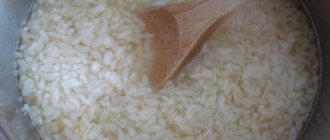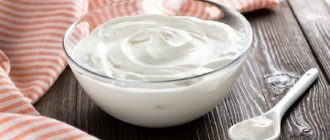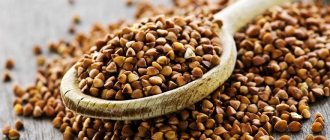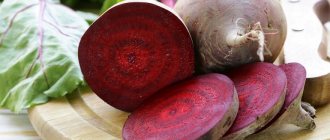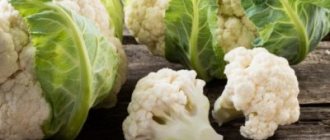Purpose of the diet
It is called “table 5p”, and is characterized as “gentle, with a reduced amount of carbohydrates (mainly sugar) and extremely low fat content”:
- daily calorie content is 2,600 – 2,800 kcal;
- proteins about 120 g/day (no more than 60% animal proteins);
- vegetable fats – about 15 g/day, animal fats – 65 g/day;
- carbohydrates – no more than 400 g;
- sugar – only 1 tablespoon/day;
- instead of sucrose - 20-30 g of sorbitol or xylitol per day;
- salt – no more than 10 g;
- liquids - 2.5 liters, without gas;
- white bread (yesterday's) - no more than 250 g/day.
Principles of the 5p table
To improve digestion in diseased organs, you need to follow the following nutritional principles:
- meals – 5-6 times a day, in small portions;
- the temperature of food taken is about 40 degrees;
- the total weight of food per day should not exceed 3 kg;
- the basis of the diet is protein foods;
- fried, salted and pickled foods should be excluded;
- vegetables should be boiled or steamed;
- soups - either vegetable or meat broth;
- drink drinks based on chicory flowers;
- Eat chicken eggs (or better yet, only whites) 2-3 times a week in the form of omelettes and boiled eggs.
What you can and cannot eat
A diet is followed in the first days of the disease while taking medications, and then doctors recommend sticking to it for a long time.
Dietary nutrition of patients is based on a sufficient intake of carbohydrates, preferably complex ones, which are contained in day-old grain bread, oatmeal, buckwheat, rice, semolina and pearl barley porridge, oatmeal or fruit and berry jelly.
Providing the body with proteins during illness occurs through the consumption of fermented milk products, especially cottage cheese, egg whites and lean meats. Turkey, chicken (without skin), rabbit, as well as veal and horse meat are allowed for consumption.
In limited quantities, you can eat low-fat ham and doctor's sausage.
Diet is considered an important stage of treatment. The following should be removed from the menu:
- fried fish and meat;
- soups with rich broth;
- vegetables, fruits, herbs;
- fatty, smoked, canned foods;
- bakery products;
- spicy food;
- alcohol.
Is it possible to use honey for pancreatitis? It all depends on the form of the disease. Nutrition should be based on simple principles:
- you need to eat food every 4 hours;
- portions should be made small and products should be ground;
- the diet should include a lot of protein products;
- consumption of carbohydrate-containing products should be reduced;
- with an exacerbation, you need to give up food for 1-2 days.
The use of honey for pancreatitis
Eating honey cannot completely replace adherence to the regimen and drug treatment for pancreatitis. Therefore, honey has a beneficial effect in combination with the listed measures.
You should not take the entire recommended dose of honey at once. Start with half a teaspoon and watch the condition change. If there are no side effects, both allergic and from the gastrointestinal tract, you can eat the entire dose. There are various methods of consuming honey:
- Drink 100 ml of honey twice a day (preferably morning and evening).
- Three times a day before meals, take 1 tablespoon of honey. The course of treatment for pancreatitis using one of the selected methods should last from one to two months.
- For constipation, you can eat 1 tablespoon of honey with aloe juice (1:1), half an hour before meals.
Honey can be taken with tea
It is important that the drink is warm. You can also dilute fruit drinks, compotes, casseroles, kefir and other products with honey
Folk recipes
There are many recipes with honey that are used in the treatment and prevention of pancreatitis. But not all are effective against inflammation of the pancreas. For example, dishes with lemon juice, garlic and fatty animal oil are unacceptable.
The following recipes will be effective for certain symptoms of pancreatitis:
- Honey and aloe. To obtain the composition, you will need to mix raw honey with aloe juice (1 tablespoon each). You can consume no more than 1 tbsp before meals. l.
- Honey with vegetable oil. The first component is taken in the amount of 1 tbsp. l., and the second - 10 drops. You need to take 1 tsp on an empty stomach.
- Honey (1 spoon) with milk (2/3 cup). The mixture should be drunk on an empty stomach and then not eaten for 4 hours.
- In its purest form. Honey is consumed without additional components, which allows you to restore a weakened body. You should start with 1 tsp. daily, and gradually you can increase the dose to 1-2 tbsp. spoons
Always follow precautions and medical rules for chronic pancreatitis
With pancreatitis, stomach acid simply damages the tissue of the pancreas, which is why it malfunctions, in simple terms. Honey improves blood circulation, nourishes the entire body with vitamins, minerals and microelements, that is, in fact, promotes rapid tissue restoration. However, you will have to follow the rules so as not to cause more harm than good, and you should never forget about them.
- You can eat honey no later than half an hour before meals, and if it turns out that lunch is ripe earlier, it’s better to wait, it will be safer and more reliable, and there will definitely be more benefit.
- Try not to consume honey together with other bee products, for example, propolis or pollen, since the amount of substances entering the body will be much more difficult to control.
- Honey should not be taken together with medications for pancreatitis; about an hour or at least forty-five minutes should pass between doses.
- If in the acute stage you feel vomiting and nausea, the temperature has risen, then you should completely abandon honey, this is not even worth discussing.
- For consumption during pancreatitis, it is better to choose honey from the honeycomb, that is, the lids of the honeycombs that bees use to seal them. It contains particles of pollen, as well as wax, which, among other things, also cleanses the intestines.
You also need to know that such a complex disease involves the gradual introduction of honey into the diet, and eating a glass of honey in one sitting will not only be reckless, but also really harmful. You need to carefully, starting with half a teaspoon, increase the amount of product consumed per day. Moreover, the maximum dose will be one or two tablespoons, so be careful and careful.
Chronic form
Please note that this sweet product does not treat pancreatitis. It will not be effective as a therapeutic method. And in some cases this can be harmful. Is it possible to eat honey with chronic pancreatitis? This product is approved if there is no intolerance. It has an auxiliary effect that improves the human condition.
Honey should be introduced into the diet gradually, starting with 1 tsp. in a day. And over time the dose should be increased. In case of deep remission, 2 tbsp will be harmless to health. l. per day. But you need to be careful, since the safest and most useful product, within unreasonable limits, can be a powerful poison. Honey is consumed in its pure form, as well as with tea, fruit juice, and compote. Over time, the ingredient can be added to casserole, cottage cheese or kefir. If there is no exacerbation, sweetness is added even to unpalatable baked goods.
Product properties
The benefits of real honey for diseases of the pancreas are quite great, if you follow the measure:
- the product has an antiseptic effect on the body, facilitating the course of the inflammatory process;
- stimulates metabolism, simplifying the task for the damaged area;
- strengthens the immune system and saturates the weakened body with vitamins;
- has a mild laxative effect and does not irritate the intestinal walls.
Honey has valuable beneficial properties that have a beneficial effect on human health.
Taken together, the properties of honey help achieve some improvements, but it is not recommended to completely switch to treatment with a folk remedy. In addition, before taking the product, you should test your glucose levels before and after meals. This will help identify hidden diabetes mellitus, which is a common complication.
The use of “sweet amber” for inflammation of the pancreas can not only stabilize the patient’s condition, but also cause harm. The patient will begin to notice loss of appetite, spasms and discomfort in the affected area, and allergic reactions may occur.
The benefits and harms of honey during illness
Before answering whether it is possible to eat honey with pancreatitis or whether it should be completely excluded from the list of permitted foods, it is worth considering what kind of sweet substance this substance affects the functioning of the pancreas:
- Simple carbohydrates (fructose and lactose), which form the basis of honey delicacy, do not require special enzymes for breakdown and are almost completely absorbed in the intestines in the form in which they entered the stomach, providing the human body with energy for vital processes (all organs and tissues receive energy from carbohydrates). This means that the pancreatic secretory function is almost not activated and no tension is created during the work of the diseased organ.
- The antiseptic components of the product have a general, anti-inflammatory effect, helping the body fight pathogens of infectious processes and preventing stagnation. With their help, it is possible to prevent various pancreatitis exacerbations of an inflammatory nature. If you regularly eat honey in moderate quantities on an empty stomach, then this measure will increase the duration of remission and reduce the severity of pathological phenomena during an exacerbation of the inflammatory process.
- The ability to accelerate tissue healing and partially promote regeneration after an acute attack (regular consumption of beekeeping products in small doses makes it possible to even restore some of the organ functions lost during illness). But the honey component should be introduced into the menu during the recovery period under strict medical supervision with a gradual increase in the dosage of the product (consuming a large amount without first preparing the body will cause a second attack).
- The components included in the honey composition not only contribute to the overall strengthening of the immune system, but also increase the ability of the pancreas to withstand adverse factors and reduce the risk of inflammatory processes in the organ.
- The mild laxative effect, characteristic of most honey-based beekeeping products, allows you to cleanse the intestines of toxins and waste, normalize its functioning in case of a tendency to constipation, which often occurs in the advanced stages of the disease.
Zabrusny honey
This is a special honey that contains honeycomb caps and a certain amount of wax. The bar itself is an indicator of the maturity of the bee product, that is, its presence indicates that the honey already contains a full range of useful substances. If you want to learn more about the properties of this beekeeping product, we recommend reading the article about bee strands.
Honey with zabrus kills pathogenic microorganisms, improves intestinal motility, and maintains the normal tone of the duodenal papilla, where the pancreas opens. It also normalizes hematopoiesis and takes an active part in fat metabolism.
Treatment of pancreatitis with honey recipes
Based on honey, traditional medicine offers many remedies that support the body and help prolong remission. Below are the most popular and effective recipes.
Water with honey for pancreatitis
Honey water helps get rid of swelling. The concentration of bee product in the drink is small, so introducing it into the diet in this form is easier for the pancreas. The liquid gives the body the necessary amount of glucose without loading the diseased organ.
To prepare, take 500 ml of water, dilute 1 tablespoon of honey in it and stir thoroughly.
How to take : drink 1 glass of folk remedy before each meal (half an hour before). The drink must be at room temperature.
Aloe with honey for pancreatitis
The mixture helps with bloating and constipation, which often bother patients with pancreatitis. The disinfecting effect of aloe and honey relieves irritation from the mucous membranes and promotes better digestion.
To prepare the medicine, you need to get aloe juice. To obtain it, it is better to use the lower large sheets. Mix honey and aloe juice in proportions 1:1. Stir until smooth. Store the finished product in the refrigerator for no more than a week.
How to take: 1 teaspoon 30 minutes before meals 2-3 times a day. The course lasts 1-2 months.
Article on the topic: Aloe and honey: traditional medicine guru
Milk with honey for pancreatitis
The drink contains the enzyme lysozyme, which has an antibacterial effect and promotes rapid healing of the mucous membrane. Milk contains easily digestible proteins necessary for the patient. Together with honey, the product helps with metabolic disorders, heartburn and bloating.
Choose milk with a low fat content. Boil 200 ml and cool to +50 degrees. Add 1-2 teaspoons of honey.
How to take: Drink 1 glass of the drink in the morning on an empty stomach or half an hour before bedtime. At the same time, it must be warm, but not hot.
Article on the topic: Milk with honey: goodbye cough!
Kefir with honey for pancreatitis
Calcium from kefir is better absorbed by the patient’s body than from fresh milk. Microorganisms in the drink improve digestion and normalize the gastrointestinal tract; kefir with honey will help get rid of constipation and bloating due to pancreatitis.
To prepare, take low-fat and non-acidic kefir. Add 1-2 teaspoons of honey to 200 ml of slightly warmed product. Stir until smooth.
How to take: drink the mixture at room temperature before meals. Start with ¼ glass per day. If the reaction is favorable, increase the daily dose to 1 glass.
Oat decoction with honey for pancreatitis
Oats are the main dietary product taken for pancreatitis. A decoction of cereal improves blood circulation and has an anti-inflammatory effect. Its use will help relieve nausea and abdominal pain.
Wash the grains thoroughly, sort and dry. Pour a glass of oats with a liter of boiling water and cook over low heat for 20 minutes. Leave in a warm place for 12 hours. Before drinking, add 1-2 teaspoons of honey to 200 ml of drink.
How to take: drink ⅓ glass half an hour before meals, 2 times a day.
Article on the topic:
For cholecystopancreatitis
If a person has been diagnosed with this disease, then he should consume honey at least 2 times a day, what are the recommendations for treatment:
- the product, in small quantities, is introduced into the diet;
- eat it on an empty stomach with a small amount of liquid.
In this case, it is necessary to take medications and monitor your diet; it is prohibited to consume:
- Fried, fatty foods.
- Products that irritate the gastrointestinal tract.
- Fast food.
It is better to bake or cook dishes, do not overeat, and eat small portions every 3 hours. You should also give up all bad habits, this will help stop an attack of the disease and reduce the risk of its relapse.
Allowed types of honey
Today, on the shelves of large supermarkets and small retail outlets you can find a huge amount of different types of honey. In order for the effect to be most effective, you should learn to evaluate the product by the nature of its composition. The concentration of medicinal components in honey directly depends on the type of plants from which the nectar was collected, the season of honey collection and where exactly the bees made the natural sweetness.
Expert opinion: the largest amount of useful microelements is contained in dark varieties of honey. Accordingly, to use the product for medicinal purposes, it is better to use these particular types. And an even more useful product is honeycomb, in which the concentration of medicinal components is several times higher than the content of the same elements in honey.
As described above, the highest quality honey is of dark varieties, which include: buckwheat, chestnut, made from acacia, and also the most common in the treatment of pancreatitis - zabrusny.
The chemical composition of raw honey is fundamentally different from the composition of all other types of product. Its potential is capable of cleansing the human body of almost all possible pathogenic microorganisms. This sweetness stimulates the microflora of the gastrointestinal tract, significantly reduces inflammation and cleanses the digestive system, removing accumulated enzymes and microbacteria from the ducts of the gland and the cavity of the small intestine.
Photo gallery of species
What type of honey is best to use?
The best option for the treatment of pancreatitis is a bar. This is a bee product containing honey, honeycomb parts, wax, propolis. The inclusion of these ingredients increases the effectiveness of the healing product by expanding the list of useful substances.
Zabrus has a positive effect on the gastric mucosa: it destroys microbes, stimulates peristalsis of the intestinal tube, and has a beneficial effect on the functioning of the duodenum. The lining has a positive effect on the formation of blood cells.
If pure bee nectar is used, doctors recommend choosing dark varieties:
- buckwheat;
- acacia;
- chestnut.
Buckwheat, acacia and chestnut honey
This is due to the increased concentration of beneficial components. The main recommendation is to choose a natural product from trusted beekeepers.
Diet for chronic pancreatitis
It is called “table 5p”, and is characterized as “gentle, with a reduced amount of carbohydrates (mainly sugar) and extremely low fat content”:
- daily calorie content is 2,600 – 2,800 kcal;
- proteins about 120 g/day (no more than 60% animal proteins);
- vegetable fats – about 15 g/day, animal fats – 65 g/day;
- carbohydrates – no more than 400 g;
- sugar – only 1 tablespoon/day;
- instead of sucrose - 20-30 g of sorbitol or xylitol per day;
- salt – no more than 10 g;
- liquids - 2.5 liters, without gas;
- white bread (yesterday's) - no more than 250 g/day.
Consumption at different stages of the disease
For inflammation of the pancreas, diets are prepared for each form of the disease, taking into account the complications and individual characteristics of the patient. The rigidity of the diet depends on the stage and dynamics of the development of the disease; for example, in advanced cases, the patient may be prescribed short-term fasting. This rarely happens, only if the organ responsible for the production of enzymes is in critical condition and is not able to withstand even a slight load.
Fasting is recommended during attacks of pancreatitis
When chronic inflammation worsens, self-treatment of pancreatitis with honey is unacceptable, since the gland does not function properly. To reduce the likelihood of complications and allow the weakened organ to recover, any food is excluded from the diet for several days, leaving only drinks in it. Fasting can last up to 4 days, and when leaving this state, food is introduced very slowly. In the first month, you should completely forget about sweets.
Consumption of honey for chronic pancreatitis is possible in the absence of diabetes mellitus during the period of remission. Before including the product in your diet, you should consult with your doctor, conduct a test and get tested for blood glucose levels. You should also find out about the safe dosage at the clinic, because the permissible amount of sweets depends on the characteristics of the course of the disease.
With simultaneous inflammation of the gallbladder and pancreas, honey is useful and is introduced into the diet when the exacerbation subsides, if there are no other contraindications. This product helps maintain the tone of the excretory ducts and breaks down fats, partially facilitating the functioning of organs involved in metabolism. For the described disease, it is not recommended to take flower varieties of “sweet amber”.
Treatment of stomach diseases
The healing effect of honey is completely determined by its composition, so among the main properties of this sweet medicine it is worth noting the following:
- The carbohydrates contained in the product in the form of fructose and glucose do not require special breakdown by the gland, so pancreatic secretion is not involved.
- Has an anti-inflammatory effect. Has antiseptic and antibacterial effects. Immunity is strengthened. The general condition of the human body improves.
- Rehabilitation processes are accelerated. It has a slight laxative effect, which is important for pancreatitis, when constipation is possible. Eliminates individual signs of the disease, its symptoms.
- Promotes the healing of wounds that may occur on the pancreatic mucosa due to exacerbation of pancreatitis. Contributes to the normalization of the activities of this body.
- Increases resistance to inflammatory processes. Excellent preservation of the cell genome. Tissues lose the ability to degenerate under the influence of the disease.
- Taking honey helps normalize metabolic and digestive processes and fat metabolism.
- Promotes the appearance of new blood cells that are located in the human bone marrow. This is how the composition of the blood is gradually renewed.
- This remedy is an excellent antioxidant that kills radicals that cause inflammatory processes.
But you should not forget that the product can be dangerous to the health of the patient. Insulin is required for glucose absorption to occur. It is produced by the so-called beta cells contained in the islet apparatus of the pancreas. During illness, this organ can be damaged to varying degrees, as a result of which the level of produced substances immediately drops. The consequence can be a condition in which the incoming proteins are easily digested, and this will be the basis for the development of diabetes mellitus.
The use of the product is prohibited for those who have allergies or a tendency to hypersensitivity or allergic reactions. This is due to the fact that honey itself is a very strong allergen that can activate pathological processes in the body. Therefore, before using the product, you should do allergy tests.
The patient's diet is based on eating often, but in small portions. Usually meals are taken every 4 hours
Compound
Honey contains B vitamins (B1, B5, B6, B9), vitamin C, niacin PP.
In addition to vitamins, it contains micro and macroelements:
- Iron is part of hemoglobin and is involved in redox processes in cells. Lack of iron in the body leads to anemia and exhaustion.
- Iodine is one of the important components of thyroid hormones and is necessary for its normal functioning.
- Potassium – is involved in muscle activity and protein synthesis, maintaining acid-base balance. Deficiency leads to cardiac dysfunction and paralysis of muscle tissue.
- Calcium – forms bone and dental tissue, conducts neuromuscular impulses. Deficiency affects the condition of bones and teeth, causing osteoporosis and muscle cramps.
- Copper is essential for the functioning of the nervous system.
- Phosphorus - this macroelement takes part in energy conversion and bone formation, and has a positive effect on memory. Prevents the appearance of rickets and skeletal pathologies.
- Manganese – participates in metabolic processes and brings them back to normal.
- Chlorine is part of the gastric juice, normalizes digestion, removes carbon dioxide and waste from the body.
Important! This is a very high-calorie product, its energy value per 100 grams is 328 kcal. One teaspoon contains 30 kcal.
The benefits and harms of honey
The tasty and sweet result of bees' activity is a simple carbohydrate containing glucose and fructose, which are easily broken down by pancreatic enzymes. For pancreatitis, it works as an antiseptic: it relieves inflammation, protects against pathogens, heals, and nourishes the immune system.
The delicacy will also be beneficial for cholecystitis, as it is involved in the metabolism of fats and helps the excretory ducts of the pancreas and gall bladder remain in working order.
However, honey is not always good for the pancreas; it can also have harmful effects:
- This beekeeping product is a powerful allergen, and for such patients this is fraught with dangerous consequences.
- Excessive consumption activates the production of pancreatic enzymes, which will increase pain.
In diseases of the pancreas, enzymes for digesting food are produced in insufficient quantities. Foods rich in carbohydrates take a particularly long and difficult time to digest. A common product high in carbohydrates, including sugar.
Patients with pancreatitis adhere to a preventive diet that excludes the consumption of sugar and sweets containing it. Confectionery, chocolate, sweets, and ice cream are prohibited. For those with a sweet tooth, it is extremely difficult to completely give up their favorite treats, especially since they have to follow the diet for a long time.
In order to diversify your diet a little and not deny yourself everything, you can include natural honey in your diet. A product of natural origin will bring more benefits to the body than manufactured products and will satisfy the need for sweets. Reasonable consumption of honey for pancreatitis will not harm your health.
You can eat honey on its own, add it to meat sauces or salad dressings, or pour it over pancakes or pancakes. It is useful to use honey instead of sugar as a sweetener for porridges, puddings, and casseroles.
Benefit
Honey is traditionally used in folk medicine and is recognized as a “natural” medicine” by modern specialists.
Honey is especially often recommended in the complex treatment of seasonal diseases - epidemics of ARVI and influenza, colds, coughs and runny nose. The natural product activates a person’s own immunity, strengthens the body’s ability to resist infections and viruses.
Beekeeping products are used to relieve inflammation of various natures. They are natural antiseptics and can inhibit the growth of pathogenic bacteria, normalizing metabolism in the cells of tissues and organs.
The substances contained in honey promote tissue regeneration and healing of internal organs. Honey compresses are used externally for warming, restoring the skin, and caring procedures.
The taste and aroma of honey improves mood, relaxes and soothes. The sweet medicine is rich in vitamins and minerals.
Excessive consumption of bee products can be harmful to health.
The most common negative reaction is an allergy. It is characterized by rashes on different parts of the body and face, itching, tearing, and sneezing. In severe cases, difficulty breathing and the development of Quincke's edema may occur.
The product can be used not only to improve the taste of dishes, but also to treat other symptoms. When considering the question of whether it is possible to take honey for pancreatitis, one should also take into account the harm if you do not follow the recommendations.
A little about the hardware itself
The pancreas is structured as follows. Most of the organ is occupied by exocrine cells, which are responsible for the production of digestive enzymes. Only in some parts of the gland are the islets of Langerhans located - areas without ducts connected to the blood, in which different cells produce various hormones, including insulin. The function of insulin is to convert carbohydrates into an energy substrate. If this hormone is not enough or is not perceived normally, the blood sugar level rises, which leads to the development of the disease.
The relationship of the pancreas to carbohydrates
Carbohydrates are needed for our body: all organs, and especially the brain, receive energy from them. The body understands not the complex polysaccharides found in fruits and berries, baked goods, pasta and sweets, but their parts - monosaccharides. The pancreas converts them into this form with the help of certain enzymes, and insulin works directly with simple sugars.
Folk remedies for heartburn - the best recipes
If the structure of the pancreas is damaged, it becomes very difficult for it to cope with carbohydrates.
Warning! Honey consists entirely of simple carbohydrates (mainly glucose and fructose) dissolved in a small amount of water, meaning the pancreas needs to work to process it anyway. But the activity of the organ will not be the same as when breaking down complex carbohydrates, but less - there will be no need to involve the enzymatic function (carbohydrates are already simple).
So we come to the question of whether honey can be used for pancreatitis. The answer to this is as follows: if the inflammation occurs chronically, while the islet (endocrine) part of the organ is not involved, then this bee product can be eaten in moderation. If there is swelling of the gland, or diabetes mellitus has developed as a result of pancreatitis, honey, like other carbohydrates, should not be contained in the diet.
How to use the product correctly
Modern dietetics does not provide special requirements for the choice of honey for pancreatitis. They do not differ from the standard ones in case of illness. The main requirement is the naturalness of honey. No foreign impurities or synthetic additives are allowed in the composition
It does not matter from which plant the honey is collected. The patient is guided by his own preferences
Eating honey for pancreatitis is allowed only in the stage of stable remission, when the patient does not complain of abdominal pain, nausea or stool disorders.
- Consume 2 tablespoons of the product per day.
- Start consuming the product with a minimum amount and carefully monitor your condition.
- If, in response to consuming the product, abdominal pain, vomiting or an allergic reaction occurs, you will have to exclude honey from your daily diet for a while.
- It is strictly forbidden to eat honey during the acute stage of the pathological process.
- After the condition normalizes, you need to wait some more time.
It is beneficial for the body to drink a glass of warm boiled water on an empty stomach in the morning with the addition of a teaspoon of honey. The beekeeping product is used as a sugar substitute and added to tea. It is allowed to consume the sweetness separately as a bite or dissolve it in a glass of warm drink.
If the patient is diagnosed with diabetes, you will have to stop eating the treat. You will need to undergo a full examination of the condition of the pancreas
It is recommended to do an ultrasound scan of the organ, paying close attention to the condition of the islet cells. It is necessary to conduct a biochemical blood test
If a patient has diabetes, the utilization of glucose in the body will be impaired, and most carbohydrates will have to be excluded from the diet.
If, with chronic pancreatitis, the patient strictly adheres to the diet, following the doctor’s recommendations, consuming honey for pancreatitis is acceptable and will benefit the patient’s body.
Indications and contraindications
It is recommended to consume honey for all sick and healthy people who are not limited in carbohydrate intake.
This product should not be taken if there are contraindications such as:
- Psychological disorders;
- Exacerbation of gastritis and ulcers;
- Allergic reaction;
- Urolithiasis disease.
This product can be used with extreme caution in case of diabetes, pregnancy, obesity and lactation. As a rule, in these conditions it is not prohibited to use this product, but this should be done in limited quantities.
